Appendix B
FLORA AND FAUNA
Despite the relative aridity of the region in which the Naval Base is located, the flora and fauna are abundant enough to warrant a book in themselves. This appendix will not be scientifically complete due to the lack of personnel trained in biology and botany and also due to a lack of reference books on the subject.
Trees and Shrubs
Of the trees native to the Base only the Cuban mahogany is of significant size. A number of these trees still stand on the Base although many have been cut for their beautiful wood. Other native trees are relatively small and of no value as timber although the lignum vitae is cherished for the manufacture of small wooden articles. The most numerous of the small unidentified trees are characterized by multitudinous thin branches, scantily leaved. Except in sheltered areas the tips of the branches are bare and white, denuded by the trade winds which lash the Base from January to April. Trees on hillsides adjacent to the sea have a permanent landward tilt to their tops.
Along the beaches, sea grape trees are numerous. These trees never grow to a great height. They have almost circular leaves and grape-like bunches of berries from which jelly can be made. Edging the inlets of the Bay and bordering the Guantanamo River for several miles from its mouth are mangrove trees which, in laces, form almost impenetrable "jungle".
Many trees native to Cuba and other West Indian islands have been transplanted to the Base and have prospered by dint of generous watering. These include the stely and beautiful Royal Palm, coconut palms, nad dinner palms. A small thatch palm native to the Base adds a picturesque touch.
The Royal Poinciana, namwed for M. de Poinciana, a former governor of the French West Indies has been widely planted. In May and June the bare branches of the tree become a mass of flame-colored blossoms. The Cubans recognize the similarity in their name for the tree-flamboyant.
Other trees that are conspicuous because of the great size they attain and the welcome shade they cast are banyans, several species of rubber trees, and the Spanish Laurel (which the Cubans call American Laurel).
Exotic tropical fruits thrive on the Base, particularly several varieties of mangoes. Esteemed by many, mangoes cause some individuals to break out in a painful rash which may require hospital care. Avocado, papaya, banana, orange, and grapefruit trees offer fruits to suit any taste. Sweet-sops (a kind of sugar apple), sour-sops, guavas, and pomegranates grow on the Base but are not as important to residents as the limes which also grow at Guantanamo and are so refreshing in cooling drinks.
Flowering shrubs which in their season paint the surroundings if the quarters in vivid colors include white and pink oleander, red poinsettia, several varieties of hibiscus, and bouganvilla in colors ranging from rich purple to deep crimson. A shrub with leaves almost as colorful as flowers is the croton, widely planted on the Base in a variety of colors. Nightblooming jasmine, frangipani, and a specie of gardenia give the air a special fragrance. Following the rainy season a small ground vine covers the lawns with a primrose-like yellow flower which later forms a prickly seed.
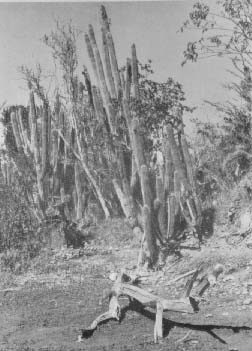 The most prevalent forms of plant life on the Base are the many varieties of cacti which flourish in all uncultivated areas.
The most prevalent forms of plant life on the Base are the many varieties of cacti which flourish in all uncultivated areas.
Birds
The Base is rich in birdlife. Along with the familiar mocking bird, sparrow, grackle, and mourning dove live strange and beautiful Cuban birds. One of these is the Cuban Tody, a gorgeous jewel no bigger than one's thumb, with a bright green back, orange bill, and geranium-red throat above a white waistcoat. By contrast the Cuban Emerald Humming Bird which is common at Guantanamo seems a very drab fellow. The Cuban Grassquit, often misnamed wild canary, is abundant.
Other birds common to the Base include the Western Red-Legged Thrush, Greater Antillean Oriole, Stolid Flycatcher, Belted Kingfisher, Cuban Green Woodpecker, and West Indian Red-Bellied Woodpecker. One bird nearly always evident is the Turkey Vulture. Others are the Cuban Blackbird, Red-Winged Blackbird, and the Tawny-Shouldered Blackbird; the American Redstart, the Palm Warbler and the Black and White Warbler.
Feathered oddities include the Cuban Lizard Cuckoo, a big, awkward brown bird with a starnge guttural voice, and the Smooth-billed Ani, a black bird with an extraordinary high-ridged bill.
The little Cuban Pygmy Owl, which hunts by day as well as night, and the Barn Owl are also found on the Base. Another bird of prey is the Sparrow Hawk.
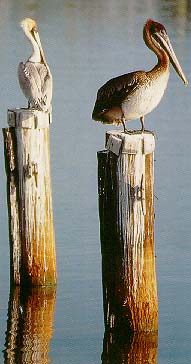 In addition to the Mourning Dove, there are White-Wing Doves and Turtle Doves in abundance. During June and July, White-crowned Pigeons flock to the mangrove islands in the Bay to nest and raise their young.
In addition to the Mourning Dove, there are White-Wing Doves and Turtle Doves in abundance. During June and July, White-crowned Pigeons flock to the mangrove islands in the Bay to nest and raise their young.
The Brown Pelican, American Snake-bird (anhinga), American Frigate Bird, and several species of gulls and terns are common at Guantanamo Bay.
Among the shore birds are the Killdeer and the Least Sandpiper.
Identification of birds of the Base has been chiefly through the pages of "Field Guide of Birds of the West Indies," by James Bond, a volume which is in great demand at the Base Library. For those interested in more details concerning birds mentioned, Mr. Bond's book is recommended.
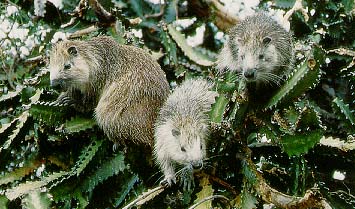 Other wildlife includes a small species of white-tail Deer, similar in size and appearance to the Florida deer, and a large tree-dwelling native rodent called the jutia (pronounced hoo-tee-ah). With brown fur, and about the size of an o'possum, the jutia has the 'possum's long bare tail, but aside from that feature more nearly resembles the woodchuck. The jutua is eaten and esteemed as a delicacy by many Cubans.
Other wildlife includes a small species of white-tail Deer, similar in size and appearance to the Florida deer, and a large tree-dwelling native rodent called the jutia (pronounced hoo-tee-ah). With brown fur, and about the size of an o'possum, the jutia has the 'possum's long bare tail, but aside from that feature more nearly resembles the woodchuck. The jutua is eaten and esteemed as a delicacy by many Cubans.
A species of boa constrictor, the Maja, reaches a length of ten feet or more and a number have been killed on the Base. The maja is non-poisonous, and apparently harmless to man, as are the other smaller snakes found on the Base. Cuba has no poisonous snakes.
There are iguanas in the crevices of the coral cliffs, and a variety of smaller lizards and chameleons are found.
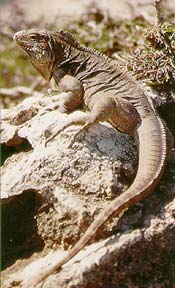 The giant tarantula and the small but deadly Black Widow spider are both present at Guantanamo Bay, as are scorpions and centipedes. Bites from these insects are uncommon. However, the same cannot be said of mosquitoes and sand flies, which at certain seasons make outdoor life after sundown miserable.
The giant tarantula and the small but deadly Black Widow spider are both present at Guantanamo Bay, as are scorpions and centipedes. Bites from these insects are uncommon. However, the same cannot be said of mosquitoes and sand flies, which at certain seasons make outdoor life after sundown miserable.
It would seem reasonable to suppose that fishing would be good at Guantanamo Bay, the vast expanse of the Bay itself, the Guantanamo River, and the Caribbean Sea offering unlimited opportunities for the angler.
Unfortunately, the fishing is not exceptional. One of the contributing factors to its mediocrity is the offshore shelf, which is so precipitous that the shallows and reefs so desirable for good fishing are notably absent.
Despite the adverse factors mentioned, there is a great variety of fish in local waters, and persistent anglers make many worthwhile catches.
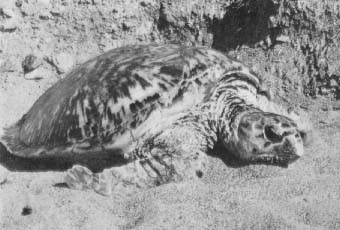 Most common game fish include the Great Barracuda, Tarpon, Kingfish, Jack, Snook, and several kinds of Snappers and Groupers. Snappers weighing more than 80 pounds have been landed at the mouth of the Guantanamo River, a favorite spot for Snapper fishing. Wahoo, Cobia, Pompano, Arctic Bonito, Falso Albacore, and even a few Sailfish have been caught in waters adjacent to the Base.
Most common game fish include the Great Barracuda, Tarpon, Kingfish, Jack, Snook, and several kinds of Snappers and Groupers. Snappers weighing more than 80 pounds have been landed at the mouth of the Guantanamo River, a favorite spot for Snapper fishing. Wahoo, Cobia, Pompano, Arctic Bonito, Falso Albacore, and even a few Sailfish have been caught in waters adjacent to the Base.
Several kinds of Sharks, including the Hammerhead, frequent the Bay and adjacent waters, as do several species of rays. Smaller fish include the Mangrove Snapper, Trigger Fish, Parrot Fish, Angel Fish, Bonefish, and many others.
 Porpoise are common in the Bay, and Manatees (sea cows) have been seen in the upper reaches of the river. Sea Turtles are often observed at the surface of the water not far from shore, and many are captured as they come ashore at night at the beaches to lay their eggs.
Porpoise are common in the Bay, and Manatees (sea cows) have been seen in the upper reaches of the river. Sea Turtles are often observed at the surface of the water not far from shore, and many are captured as they come ashore at night at the beaches to lay their eggs.
The Langosta, a spiny lobster or crayfish, is abundant in the Bay, and langostaing is a favorite sport.
Crocodiles are sometimes sighted in the river and in the mangrove labyrinths of the upper Bay, but they are undoubtedly not so common now as in the days when they gave the town of Caimanera its name.
Go to Appendix C